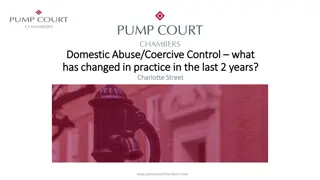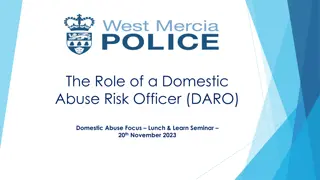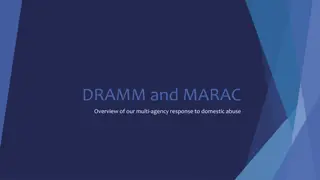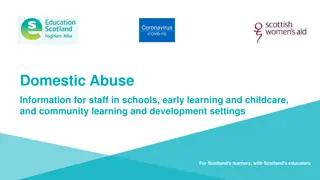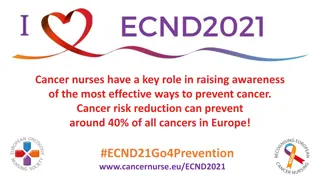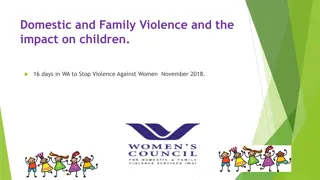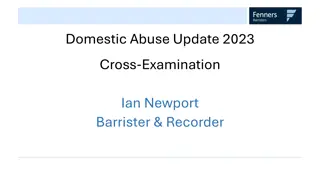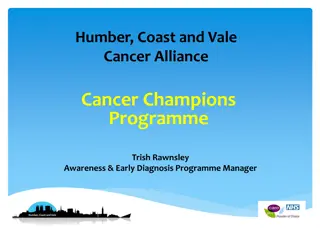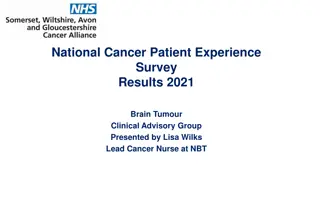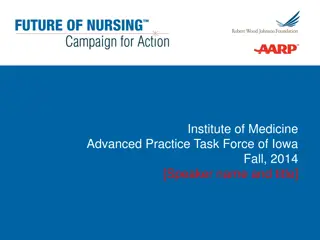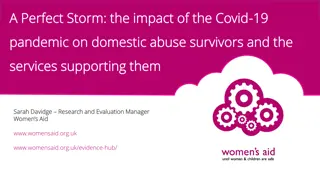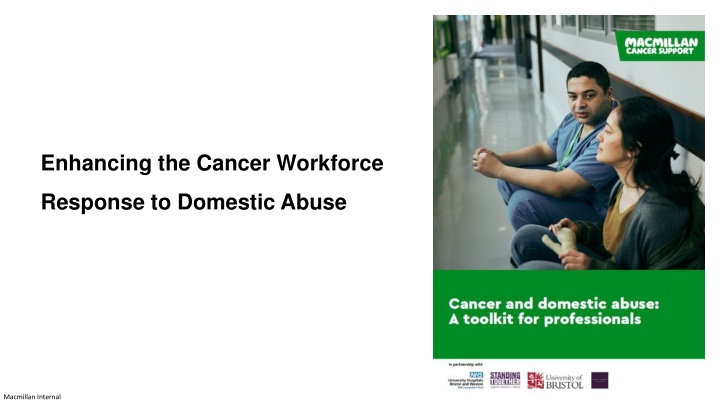
Enhancing Cancer Workforce Response to Domestic Abuse - Insights & Recommendations
Explore the intersection of cancer and domestic abuse, revealing the challenges faced by victim-survivors. Learn how professionals can improve identification and support for those affected, creating a safe space within cancer care. Discover the mission to provide comprehensive care and empower survivors.
Download Presentation

Please find below an Image/Link to download the presentation.
The content on the website is provided AS IS for your information and personal use only. It may not be sold, licensed, or shared on other websites without obtaining consent from the author. If you encounter any issues during the download, it is possible that the publisher has removed the file from their server.
You are allowed to download the files provided on this website for personal or commercial use, subject to the condition that they are used lawfully. All files are the property of their respective owners.
The content on the website is provided AS IS for your information and personal use only. It may not be sold, licensed, or shared on other websites without obtaining consent from the author.
E N D
Presentation Transcript
Enhancing the Cancer Workforce Response to Domestic Abuse 1 Macmillan Internal
Domestic abuse is an incident or pattern of incidents of controlling, coercive, threatening, degrading and violent behaviour, including sexual violence, in the majority of cases by a partner or ex-partner, but also by a family member or carer. Macmillan Internal
Cancer and domestic abuse are both extremely common and therefore some peoples experience of these two things will unfortunately overlap. Macmillan Internal
Phase 1 : Surveys and interviews with cancer professionals and survivors 1. Domestic abuse did not stop and often worsened after a cancer diagnosis. 2. Abuse affected cancer treatment, surgery, and recovery in ways that led to pain and suffering. 3. Most cancer professionals agreed that they have a responsibility to identify and respond to domestic abuse. 4. Of the victim-survivors, just 9/20 reported that they had disclosed domestic abuse to cancer professionals. 5. When referred to services, victim-survivors reported that the cancer setting led them to get domestic abuse support for the first time. 6. Professionals and victim-survivors felt that the cancer setting provided a unique opportunity for domestic abuse to be identified and responded to. 7. But lack of confidence and knowledge was a barrier to a good response. 8. Victim-survivors wanted professionals to make the setting a clear safe space for disclosure and offer support and signposting 9. Professionals were eager to improve their response to domestic abuse. Macmillan Internal
I had thought that cancer would make the abuse stop but it gave an excuse for it to get worse Victim-survivors were overall extremely positive about their cancer care and thought these professionals were well-placed to make a difference regarding domestic abuse: Some amazing health workers out there who could make such a difference Macmillan Internal
Our mission statement: We want the cancer setting to offer a safe time and space for victim-survivors of domestic abuse to get the support they need, from skilled and confident healthcare workers and cancer professionals. Macmillan Internal
Phase 2 : Evaluation of domestic abuse training for the cancer workforce Macmillan Domestic Abuse Co-ordinators trained 1080 staff across the two locations. Training significantly increased confidence in asking about and responding to domestic abuse and reduced perceived barriers to doing so. (Dheensa, forthcoming) Macmillan Internal
Marion Macmillan Internal
A toolkit for cancer professionals Quick reference guides Terminology and definitions Who is at risk? Domestic abuse in the cancer setting Red flags to look out for What to do if you suspect someone is experiencing domestic abuse Risk management Caring for yourself References Positive feedback Macmillan Internal
Key reflections, relevant to the cancer workforce A diagnosis of cancer can be a trigger for DA to start or exciting DA to escalate The perpetrator of DA, could be the patient, patient s partner, close family member Victim/survivors of DA, view cancer professionals as trusted people to talk to Victim / survivors of DA, view cancer hospital appointments as safe places On the whole, victim/survivors want staff to identify and respond to what they see Macmillan Internal
Remember the intersection of cancer and domestic abuse Research says 1:5 people in the UK will be a victim / survivor of DA 1:2 people born in the UK will have a cancer diagnosis in their lifetime DA can affect cancer diagnosis, care, treatment and recovery Relevant to the whole cancer workforce Remember to think outside the cancer box Cancer can mask DA red flags Have a lower threshold of suspicion Abusers will use discussions around how hard it is for partners and spouses to their benefit. When someone shouts & swears at you it s abuse. (abuse and cancer survivor) Macmillan Internal
Next Steps Opportunities to embed key learning into existing training structures Safeguarding / Domestic Abuse Cancer related training / induction / communication skills Raise awareness and access to the Macmillan cancer and domestic abuse cancer professional s toolkit SWAG Cancer Alliance funding 18 months Dedicated cancer and domestic abuse expertise to roll-out Macmillan training across all SWAG Trusts and explore a training model within Integrated Care Systems and Primary Care. Develop a sustainable future cancer workforce training model SWAG Somerset Wiltshire Avon and Gloucestershire Cancer Alliance Macmillan Internal
What can you do now? 1) Read and share the toolkit 2) Join our National Working Group Macmillan Internal
Having to turn to my abuser for help during my cancer treatment, after spending years trying to escape the abusive relationship, was the number one source of stress, fear, and misery during cancer treatment much worse than the treatment and the cancer itself. Macmillan Internal


